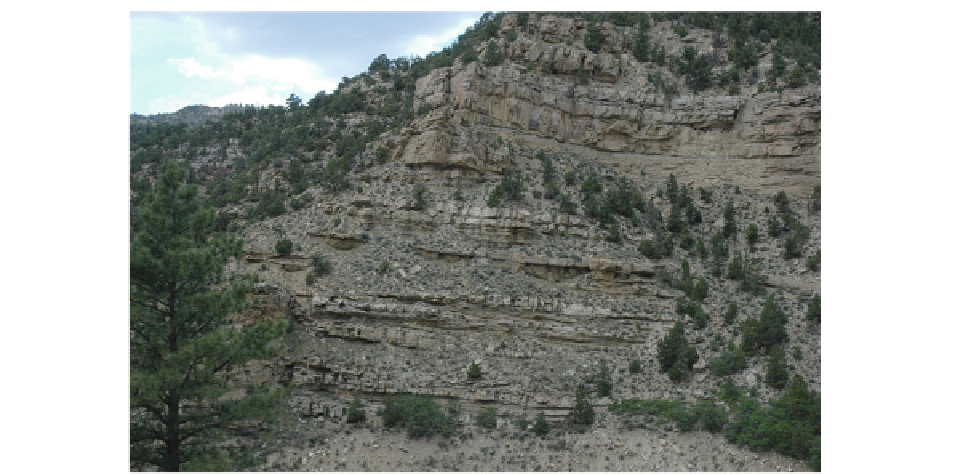Geology Reference
In-Depth Information
Fig. 17.11
Middle Castlegate fl uvial-tidal transition succession
along Willow Creek, Utah. The lower third of the 35 m succession
shows two fl uvial-tidal channel belts with multiple heterolithic
point bars containing turtle fragments and
Teredolites
-bored logs.
The recessive interval just below center contains a thick, muddy
intertidal-fl at succession (wavy and lenticular beds) passing up to
organic-rich, supratidal salt-marsh deposits (likely to be estuarine
due to association with bayhead delta deposits off photo to right).
Short cliffs above the center contain marine trace fossils. This suc-
cession is mapped to connect some 70 km basinward to the Sego
Sandstone and the transgressive Anchor Mine Tongue of the
Mancos Shale. The Bluecastle Tongue forms the upper cliffs
landward-directed, ripple- and climbing-ripple lami-
nated, trough cross-stratifi ed, plane-parallel laminated
sandstones with mud drapes and double mud drapes.
They also show fl aser to wavy bedding, and some cross-
strata with bidirectional paleocurrent directions. Tidal
inlet deposits in the same Utah succession occur
as intervals of erosionally-based bidirectional cross-
stratifi ed, low-angle planar cross-stratifi ed, plane-parallel
laminated and current-ripple laminated sandstones with
occasional mud drapes and multiple erosion surfaces
lined by shell debris and clay clasts. In places bed tops
are wave reworked and bioturbated by
Planolites
,
Ophiomorpha
,
Diplicraterion
or
Rhizocorallium
.
concentration zone, before becoming sandy again into
the landward river system where few, if any, tidal struc-
tures occur (Dalrymple and Choi
2007
) . Some of the
best known Campanian successions that contain depo-
sits of this most proximal estuarine zone include the
strata seaward of the fl uvial parts of Ericson Formation,
and landward of the Twenty-Mile, Trout Creek and
Iles marine shorelines in SW Wyoming and N.
Colorado (Fig.
17.3
) (Gomez-Veroiza and Steel
2010
) ,
the middle Castlegate Sandstone and Neslen Formation
that lie landward of the Sego, Corcoran and Cozzette
shoreline deposits in Utah and western Colorado
(Fig.
17.3
) (Aschoff and Steel
in press
) , and the
Chimney Rock Sandstone near the Utah-Wyoming
border (Plink-Bjorklund
2008
) .
The most easily recognizable tidal signals in these
deposits occur at the seaward end of the fl uvial-tidal
transition area, where point bars and inclined hetero-
lithic strata (Thomas et al.
1987
; Rahmani
1988
)
develop along the sinuous reaches of distributary and
tidal channels. Good examples of such inclined hetero-
lithic point bars containing brackish-water trace fossils
and pervasive, muddy, slack-water drapes occur in
Middle Castlegate (Fig.
17.11
) and Neslen (Fig.
17.12
)
17.2.3 Tidal Criteria: Campanian Fluvial
Tidal Transition (Inner to Mid
Estuary) Zones
Inner estuary deposits, particularly from tide-dominated
estuaries, are dominated by channel fi lls (Fig.
17.4a
)
that tend to change from being relatively sandy at the
down-dip margin of the inner estuary to markedly hete-
rolithic and sinuous in the high suspended-sediment

